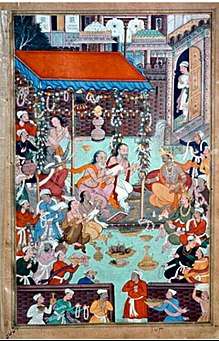Lava (Ramayana)
Lava (Sanskrit: लव) [1] and his twin brother Kusha, were the children of Rama and Sita. Their story is recounted in the Hindu epic, Ramayana and its other versions. He is said to have a whitish golden complexion like their mother, while Kusha had a blackish complexion like their father.
| Lava | |
|---|---|
 | |
| Texts | Ramayana and its other versions |
| Personal information | |
| Born | |
| Parents | |
| Siblings | Kusha |
| Dynasty | Raghuvanshi-Ikshvaku-Suryavanshi |
Lava is purported to have founded Lavapuri[2] (the modern day city of Lahore),[3] which is named after him.[4]
Lava was the younger brother and Kusha was elder.
Birth and childhood


According to the Ramayana, Sita banished herself from the kingdom due to the gossip of the kingdom folk about her sanctity. She chose self exile and took refuge in the ashram of Sage Valmiki located on the banks of the Tamsa river.[5] Lava and Kusha were born at the ashram and were educated and trained in military skills under the tutelage of Sage Valmiki. They also learned the story of Rama.

Ashwamedha Yagya
During an Ashvamedha Yagya held by Rama, Sage Valmiki along with Lava and Kusha, attended with Sita in disguise.
Lava and Kusha chanted the Ramayana in the presence of Rama and a vast audience. When Lava and Kusha recited about Sita's exile, Rama became grief-stricken and Valmiki produced Sita. Sita, struck with embarrassment and grief, called upon the earth, her mother (Bhūmi), to receive her and as the ground opened, she vanished into it. Rama then learnt that Lava and Kusha were his children.
In some versions, Lava and Kusha capture the horse of the sacrifice and defeat Rama's brothers and their army and when Rama came to fight with them, Sita intervened and unites father and sons.
Later history
Lava and Kusha became rulers after their father Rama and founded the cities of Lavapuri (current day "Lahore") and Kasur respectively. The king of Kosala Raghava Rama installed his son Lava at Sravasti and Kusha at Kushavati.[6]
There is a temple associated with Lava (or Loh) inside Shahi Qila, Lahore.[7]
See also
References
- https://web.archive.org/web/20131004215927/http://www.lcuk.org.uk/history.htm. Archived from the original on 4 October 2013. Retrieved 14 November 2010. Text " Community United
" ignored (help); Missing or empty
|title=(help) - Bombay Historical Society (1946). Annual bibliography of Indian history and Indology, Volume 4. p. 257.
- Baqir, Muhammad (1985). Lahore, past and present. B.R. Pub. Corp. pp. 19–20. Retrieved 29 May 2009.
- Masudul Hasan (1978). Guide to Lahore. Ferozsons.
- Vishvanath Limaye (1984). Historic Rama of Valmiki. Gyan Ganga Prakashan.
- Nadiem, Ihsan N (2005). Punjab: land, history, people. Al-Faisal Nashran. p. 111. Retrieved 29 May 2009.
- Ahmed, Shoaib. "Lahore Fort dungeons to re-open after more than a century." Daily Times. 3 November 2004.
.jpg)